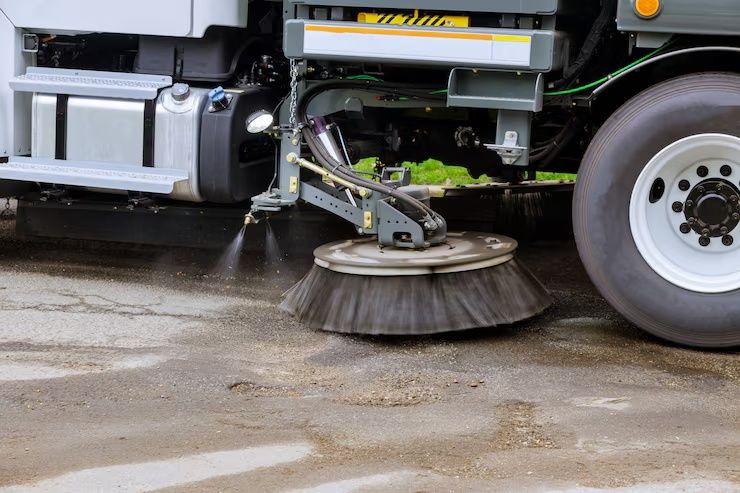Industrial sweepers are machines designed to clean large commercial and industrial spaces efficiently. Unlike household brooms or vacuum cleaners, industrial sweepers are engineered to handle heavy-duty cleaning, including dust, debris, and liquids, over expansive surfaces such as warehouses, factories, parking lots, and construction sites.
Importance
Industrial sweepers offer significant advantages for businesses, facilities, and public spaces:

-
Enhanced safety: Removing dust, debris, and spills reduces workplace accidents and slips.
-
Efficiency: Large areas can be cleaned quickly compared to manual methods, saving time and labor.
-
Environmental benefits: Dust containment systems minimize air pollution and particulate matter.
-
Compliance with regulations: Supports adherence to occupational safety and environmental cleanliness standards.
By improving cleanliness, safety, and productivity, industrial sweepers are essential tools for operational management in commercial and industrial environments.
Recent Updates
Recent trends and technological advances in 2023–2024 highlight improvements in industrial sweepers:
-
Electric and battery-powered models: More eco-friendly machines reduce noise, emissions, and energy consumption.
-
Autonomous sweepers: Robotic models use AI and sensors to operate with minimal human supervision.
-
Integrated dust filtration: Advanced HEPA and multi-stage filters capture finer dust particles.
-
Hybrid models: Machines that combine sweeping with vacuuming or scrubbing functions increase versatility.
-
IoT-enabled monitoring: Smart industrial sweepers provide real-time performance data, maintenance alerts, and operational analytics.
-
Global adoption: Increased use in Asia-Pacific, Europe, and North America due to industrial expansion and stricter hygiene regulations.
These developments reflect a shift toward sustainability, automation, and precision cleaning.
Laws or Policies
The deployment and use of industrial sweepers are influenced by regulatory frameworks to ensure safety, efficiency, and environmental compliance:
-
Occupational safety standards: Regulations such as OSHA guidelines in the United States govern safe cleaning practices and equipment operation.
-
Environmental policies: Air quality and dust emission limits may affect industrial cleaning methods.
-
Energy efficiency directives: Some countries incentivize battery-powered or low-emission cleaning equipment.
-
Workplace hygiene requirements: Industrial, food processing, and pharmaceutical facilities must comply with cleanliness standards to maintain certifications.
-
Equipment certification: CE, UL, or ISO certifications ensure machines meet international safety and quality standards.
Compliance with these policies ensures safe, effective, and environmentally responsible cleaning operations.
Tools and Resources
Various tools and resources support industrial sweeper operators, facility managers, and engineers:
-
Maintenance apps: Schedule preventive maintenance, track performance, and log repairs.
-
Cleaning optimization calculators: Estimate cleaning time, coverage, and resource allocation.
-
Operator training modules: Provide guidelines for safe and efficient equipment use.
-
Supplier datasheets: Technical specifications, power requirements, and operational limits.
-
Industry associations: Organizations such as ISSA (International Sanitary Supply Association) offer research, training, and guidelines.
-
Online benchmarking tools: Compare machine efficiency, energy use, and environmental impact.
Example Table: Types of Industrial Sweepers
| Sweeper Type | Function | Key Advantage |
|---|---|---|
| Ride-on Sweepers | Large-scale sweeping for warehouses/factories | High efficiency, large coverage |
| Walk-behind Sweepers | Medium-sized areas like parking lots | Maneuverable, versatile |
| Robotic/Autonomous | AI-controlled automated cleaning | Reduced labor, continuous operation |
| Battery-powered Sweepers | Electric operation for indoor use | Low emissions, quiet operation |
| Hybrid Sweeper-Vacuum | Sweeping combined with vacuuming or scrubbing | Versatile, fine dust collection |
This table illustrates the variety of sweepers suitable for different industrial cleaning applications.
FAQs
What is an industrial sweeper?
An industrial sweeper is a machine designed to clean large commercial or industrial spaces by collecting dust, debris, and liquids efficiently.
Which industries use industrial sweepers most?
Warehouses, manufacturing plants, construction sites, food processing facilities, parking garages, and airports commonly use sweepers.
What are the advantages of autonomous sweepers?
They reduce labor requirements, can operate continuously, and provide consistent cleaning performance with minimal supervision.
How often should industrial sweepers be maintained?
Regular maintenance should follow manufacturer guidelines, typically including daily inspections, weekly cleaning of brushes and filters, and periodic servicing of mechanical components.
Conclusion
Industrial sweepers are vital tools for maintaining cleanliness, safety, and operational efficiency in commercial and industrial environments. Their evolution from manual sweepers to battery-powered and autonomous models reflects ongoing innovation in technology, sustainability, and precision cleaning.
By adhering to safety and environmental regulations, using modern tools and resources, and selecting the appropriate type of sweeper for specific applications, facilities can ensure reliable performance, enhanced safety, and compliance with standards.
The integration of smart technologies, energy-efficient designs, and advanced dust filtration continues to make industrial sweepers a cornerstone of industrial hygiene and productivity worldwide.